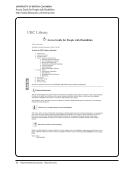SPEC Kit 321: Services for Users with Disabilities · 17
Survey Questions and Responses
The SPEC survey on Services for Users with Disabilities was designed by M. Suzanne Brown, Research
Assistance, Instruction &Outreach Services Librarian, University of Florida. These results are based on data
submitted by 62 of the 125 ARL member libraries (50%) by the deadline of October 15, 2010. The survey’s
introductory text and questions are reproduced below, followed by the response data and selected comments
from the respondents.
When ARL last gathered information from member libraries about services for users with disabilities more than 10 years ago,
several trends emerged. Library staff were encountering a broad range of disabilities from a growing number of users. While federal
and regional regulations, such as the Americans with Disabilities Act (ADA), were leading to improvements in physical access to
libraries, more work remained, particularly in older buildings. Assistive technology was prevalent, but equipment maintenance could
be an issue. And staff training and attitudes were the weak link in the service chain. The current literature describes an ongoing
expectation of larger numbers of disabled persons to serve requiring specialized equipment that increases maintenance needs as well
as the demand for more assistance from trained staff.
Some academic and public libraries have an assigned coordinator with specialized skills to manage equipment or other services for
users with disabilities. Other libraries may include responsibility for providing assistive services in the job descriptions of all public
services desk staff. With budget declines, meeting the service needs of this library population is more challenging as all libraries,
special, public, and academic, predict the continued need to do more with less.
This survey seeks to better understand library services for users with disabilities today and how accessibility has changed for them
in the complex environments of ARL libraries. It explores what services are being provided and how users are made aware of them
what assistive technologies are being offered today and who maintains them which library staff have responsibility for providing
services and how are they trained and what service policies and procedures are in place for users with disabilities. The answers
to these questions will provide an updated snapshot of ARL library services for users with disabilities at the beginning of the 21st
century.
Survey Questions and Responses
The SPEC survey on Services for Users with Disabilities was designed by M. Suzanne Brown, Research
Assistance, Instruction &Outreach Services Librarian, University of Florida. These results are based on data
submitted by 62 of the 125 ARL member libraries (50%) by the deadline of October 15, 2010. The survey’s
introductory text and questions are reproduced below, followed by the response data and selected comments
from the respondents.
When ARL last gathered information from member libraries about services for users with disabilities more than 10 years ago,
several trends emerged. Library staff were encountering a broad range of disabilities from a growing number of users. While federal
and regional regulations, such as the Americans with Disabilities Act (ADA), were leading to improvements in physical access to
libraries, more work remained, particularly in older buildings. Assistive technology was prevalent, but equipment maintenance could
be an issue. And staff training and attitudes were the weak link in the service chain. The current literature describes an ongoing
expectation of larger numbers of disabled persons to serve requiring specialized equipment that increases maintenance needs as well
as the demand for more assistance from trained staff.
Some academic and public libraries have an assigned coordinator with specialized skills to manage equipment or other services for
users with disabilities. Other libraries may include responsibility for providing assistive services in the job descriptions of all public
services desk staff. With budget declines, meeting the service needs of this library population is more challenging as all libraries,
special, public, and academic, predict the continued need to do more with less.
This survey seeks to better understand library services for users with disabilities today and how accessibility has changed for them
in the complex environments of ARL libraries. It explores what services are being provided and how users are made aware of them
what assistive technologies are being offered today and who maintains them which library staff have responsibility for providing
services and how are they trained and what service policies and procedures are in place for users with disabilities. The answers
to these questions will provide an updated snapshot of ARL library services for users with disabilities at the beginning of the 21st
century.




































































































































































































